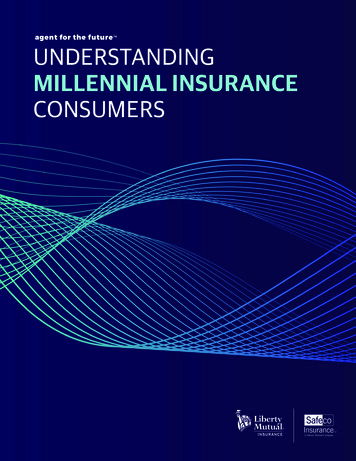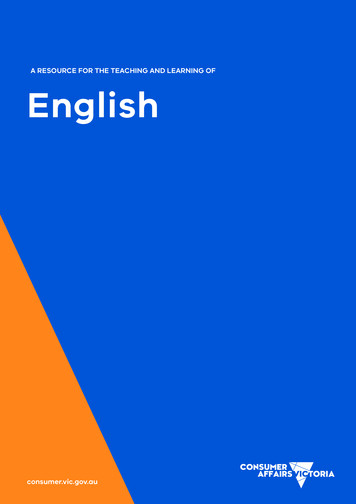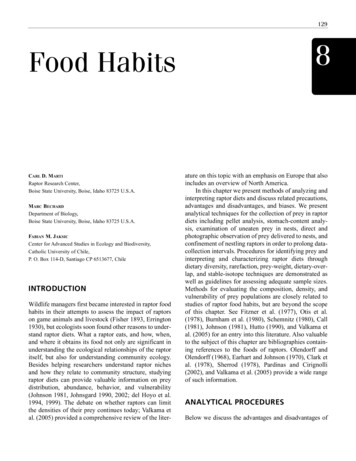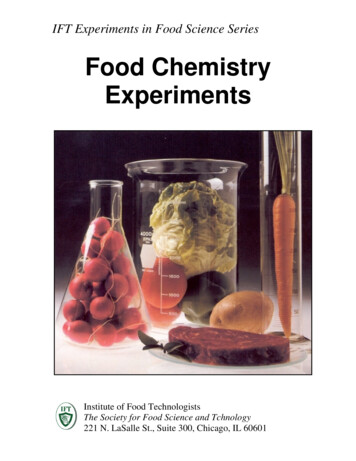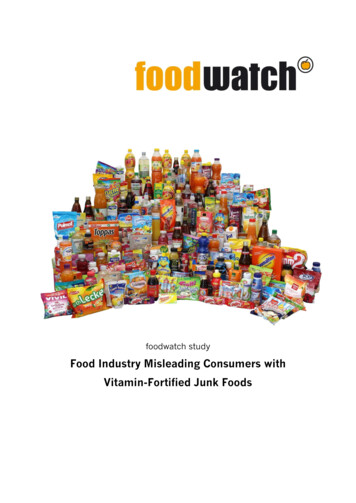
Transcription
foodwatch studyFood Industry Misleading Consumers withVitamin-Fortified Junk Foods
ImprintEditor-in-chief Thilo Bodefoodwatch e.V.Brunnenstraße 18110119 Berlin, GermanyFon 49 (0) 30 / 24 04 76 – 0Fax 49 (0) 30 / 24 04 76 – 26E-Mail info@foodwatch.deAs ofMarch 2016Seite 2 von 45
Summary“Contains 9 essential vitamins!” – In Europe, it is perfectly legal for food companies to usemarketing statements like this to sell sweets and sugary drinks. The EU has failed to establishnutritional requirements that foods must meet in order to bear nutrition and health claims. Thefood industry is shamelessly taking advantage of this situation. Food companies add vitamins tohundreds of unhealthy foods and beverages in order to market these products as healthy,thereby misleading consumers about the actual nutritional values of these products. Aninvestigation carried out by foodwatch in the Netherlands and Germany reveals the alarmingscale of this problem. The consumer rights organization evaluated the nutritional composition of644 products with claims referring to vitamin content and found that 80 per cent (515products) were in fact not healthy, for instance containing too much sugar, fat or salt. Instead ofproviding health benefits, these products contribute to poor diet and thereby to the developmentof chronic diseases. foodwatch calls on the EU to prohibit the use of nutrition and health claimson unhealthy foods.1. IntroductionPutting an end to the misleading use of false health claims – this was the aim of the EuropeanNutrition and Health Claims Regulation EC 1924/2006 (NHCR), which was passed in 2006. Inpractice, however, just the opposite occurred. Although companies are now (since 2012) onlyallowed to use health claims that are scientifically substantiated, the EU has failed to establishany nutritional criteria that foods must meet to permit the use of nutrition or health claims. As aresult, it is still perfectly legal for food companies to use nutrition and health claims formarketing products that are too high in fat, salt or sugar to be considered healthy and nutritious.The addition of a few vitamins or minerals is all it takes to give sweets or sugary drinks a healthyimage. These marketing strategies deliberately mislead consumers and torpedo their efforts tomake healthier food choices.These practices should have been prohibited long ago: the Nutrition and Health ClaimsRegulation includes provisions on “nutrient profiles”, whose purpose is to prevent the use ofhealth-related advertising on unhealthy foods. These profiles define the nutritional requirementsthat foods must meet in order to bear nutrition and health claims. According to the provisions ofthe NHCR, nutrient profiles should have been fully implemented by January 2009. That wasseven years ago – and there is still no system in place. Under pressure from the food lobby, theEU is now considering removing these provisions on nutrient profiles from the Regulationaltogether.At the same time, the widespread adverse consequences of poor diet have already become amajor societal challenge: over the past decades the world has seen dramatic increases in theprevalence of obesity and food-related diseases such as type 2 diabetes. It is estimated that 32million people in the EU already suffer from diabetes, and the numbers are growing rapidly. 1 InEurope, diabetes already accounts for over 100 billion in healthcare expenditures – every year!In order to assess the current extent of legal consumer deception associated with the use ofnutrition and health claims on unhealthy foods, foodwatch investigated hundreds of productsfrom supermarkets and discounters in Germany and the Netherlands. All products chosen forthe study had vitamin-related advertising on the front of the package. The nutritionalEuropean Parliament (2016). Written Declaration on c.do?type WDECL&reference P8-DCL-2016-0008&format PDF&language EN1Seite 3 von 45
composition of these products was evaluated on the basis of the nutrient profile modelpublished by the World Health Organisation’s Regional Office for Europe (WHO/Europe).Nutrient profiles – differentiating between apples and chocolate barsSo-called nutrient profile models are used for evaluating the nutritional composition offoodstuffs in order to determine whether they constitute a meaningful contribution to a healthydiet. Several such nutrient profile models have already been adopted in various countriesworldwide for the regulation of food advertising. 2 Numerous health organisations (including theDeutsche Diabetes Gesellschaft, the British Medical Association, the World Health Organisation,the World Cancer Research Fund, the World Obesity Federation and the European HeartNetwork) view these models as helpful instruments in the prevention of obesity and food-relatedchronic diseases.In early 2015 the WHO Regional Office for Europe (WHO/Europe) published a nutrient profilemodel as a tool for the implementation of restrictions on the marketing of foods to children. 3This model provides a means of differentiating between foods that are more likely to be part of ahealthy diet from those that are less likely, based on their nutritional compositions. The criteriaused for the WHO model include levels of fat, saturated fatty acids, sugar and salt, as well asenergy content, added sugar and non-sugar sweeteners. According to WHO/Europe’srecommendations, child-targeted marketing should only be allowed for food products thatqualify as “healthy” based on this model. However, the WHO also recommends the use ofnutrient profiles in other contexts for the promotion of healthy eating habits. 4Nutrient profiles are also enshrined in the EU’s Nutrition and Health Claims Regulation. Onlyfoods that are considered healthy based on these nutritional criteria should be allowed to carrynutrition and health claims (see Article 4). 5 In 2009 the European Commission presented its owndraft proposal for a nutrient profiling scheme. 6 However, the implementation of this proposal hasbeen delayed for seven years. At the moment, it is unclear whether these nutrient profiles willultimately be adopted, as required by the Regulation, or if they will simply be abandoned. Underthe guise of “legislative simplification” (the so-called REFIT programme), the EU is currentlyevaluating the Nutrition and Health Claims Regulation with regard to nutrient profiles. 7 In midApril 2016 the European Parliament will be voting on a proposal to eliminate nutrient profilesfrom the NHCR.8foodwatch believes that only the healthiest products should be allowed to use health andnutrition claims in their marketing. The WHO/Europe nutrient profile model offers a good basisfor such policy action. Unlike this model, the European Commission draft would allow health andnutrition claims on breakfast cereals containing up to 25 grams of sugar, as well as onsweetened beverages (for more information on the differences between the two models, seeAppendix 1). foodwatch therefore calls on policy-makers to adopt the WHO/Europe nutrientprofile model, and not the European Commission's proposal, for the implementation of theNHCR ng-frameworkhttp://www.euro.who.int/ data/assets/pdf file/0005/270716/Nutrient-Profile-Model Version-for-Web.pdf?ua 14 http://www.euro.who.int/ data/assets/pdf h-2020-Eng.pdf?ua 15 An exception is specified in Article 4, Paragraph 2 b) of the Regulation: “Nutrition claims shall be allowed, where a single nutrientexceeds the nutrient profile provided that a statement about the specific nutrient appears in close proximity to, on the same side and withthe same prominence as the claim.” For example, the statement “high sugar content” would have to appear beside the claim “high infibre”. ?uri OJ:L:2007:012:0003:0018:EN:PDF)6 http://www.senat.fr/europe/textes europeens/a0006.pdf7 /2015 sante 595 evaluation health claims en.pdf8 So-called REFIT resolution: cedure.do?lang en&reference 2014/2150%28INI%2923Seite 4 von 45
2. The foodwatch studyIn February and March 2016 foodwatch conducted research in supermarkets and discounters inGermany and the Netherlands. In each country, investigators visited three supermarkets (onefrom each of the three highest-grossing food-retail chains)9 and documented all products withvitamin-related advertising on the front of the package.10 214 such products were identified inGermany and 430 in the Netherlands. The food products identified were then categorised ashealthy or not healthy using the criteria of the WHO nutrient profile model.3. The findings: mountains of junk food with added vitaminsBe it chocolate, ice cream or sugary drinks – food manufacturers are brazenly taking advantageof European politicians’ inability to reach a final agreement on the rules for the composition offoodstuffs using nutrition and health claims. Eighty per cent of the 644 evaluated products withnutrition or health claims did not meet the nutritional criteria for healthy foods based on theWHO model.The food industry uses added vitamins and minerals on a large scale to market its junk foods ashealthy. The foodwatch study found that the majority of the unhealthy products bearing vitaminrelated advertising were either juices (92 products) or sweetened beverages (252, including 48milk drinks and 16 energy drinks). However, manufacturers of sweets (59 products), breakfastcereals (23 products) and yoghurt (drinks) (30 products) are also happy to create the illusion ofhealthiness by adding vitamins to their unhealthy products. Only very few of these claims, evenon juices, are in reference to nutrients that are naturally present in the product. In Germany,approximately 85 per cent of the vitamin-related claims identified in the study referred to addedvitamins.Food fortification is a profitable business for manufacturers: sweets and sugary beveragesalready have some of the highest profit margins, owing to their cheap ingredients. 11 With theaddition of a few vitamins – which are also inexpensive but advertised as “valuable” – the sameproduct can be portrayed as a healthier and higher-quality option. These marketing strategiesare harmful and deceptive for consumers, but beneficial for food companies. This is why thefood industry is doing everything in its power to prevent the NHCR's provisions on nutrientprofiles from being implemented.Supermarket chains with the highest market shares in Germany: Edeka, Lidl and handel-deutschland-2014); in theNetherlands: Albert Heijn, Jumbo and Lidl (http://www.distrifood.nl/service/marktaandelen)10 Excluded from the study were products for children under 36 months and food supplements (for these products, there are other lawsor recommendations for composition that apply)11 JP Morgan, Global Equity Research (2006). Obesity – Re-Shaping the Food Industry, pp. eriality2/obesity jpmorgan 2006.pdf9Seite 5 von 45
Fig. 1: Number of healthy and not healthy products, based on the criteria of the WHO model, in each of thecategories (total: 644 products).4. Conclusion and foodwatch demandsAdded vitamins usually serve only one purpose: marketingThere seems to be only one real reason why food companies add vitamins to unhealthy foodsand beverages: to market these products as “healthy”. The fortification of unhealthy foodstuffsdoes not benefit public health. For example, in a country like Germany, the vast majority ofhealthy people get all of the vitamins they need from their diets. 12,13 If a vitamin deficiency isnevertheless found or suspected (with a higher prevalence in certain populations, e.g. theelderly), the individual should seek a doctor’s advice and strive to eat a more well-balanced dietand not junk foods fortified with factory-made vitamin cocktails – particularly in view of the factthat most of these added vitamins do not follow any nutritional concept. Products that arefortified with vitamins also pose the risk of an overdose, which can have serious healthconsequences. For example, the German Federal Institute for Risk Assessment (BfR) advisesWith few exceptions; for more information: German Nutrition Society, DGE (2012). Evaluation of vitamin supplies in 13 http://www.bfr.bund.de/en/vitamins and minerals-54417.html andhttp://www.bfr.bund.de/en/press information/2005/02/new assessment of risks and benefits of vitamins and minerals in food5962.html12Seite 6 von 45
against the fortification of food products with Vitamin A (other than margarine) 14 and VitaminD15. Nevertheless, there are many sweetened “ACE drinks” containing Vitamin A, as well assugary, Vitamin D-enriched yoghurt products on the market. Food companies prey onconsumers’ fears about vitamin deficiency in order to market their products as healthy.The EU must take immediate actionThe use of health and nutrition claims in food marketing is widespread in the EU. Thousands ofproducts carry such claims.16,17,18 foodwatch’s comprehensive investigation in two Europeancountries revealed that the vast majority of these products are too high in sugar, fat or salt.These findings indicate that policies are urgently needed to define which foods are eligible tobear nutrition or health claims. The use of these claims on unhealthy products thwartsconsumers’ attempts to make healthy food choices. Instead of providing health benefits, theseproducts contribute to the rampant epidemic of unhealthy diets, and thereby to thedevelopment of chronic diseases such as type 2 diabetes.For this reason, foodwatch urges the European Commission to implement a nutrient profilemodel as foreseen in the Nutrition and Health Claims Regulation, in order to ensure that onlyhealthy foods are marketed with nutrition and health claims. The WHO Regional Office forEurope nutrient profile model in its current form can easily be adopted for this purpose.BfR (2005) Use of Vitamins in Foods. http://www.bfr.bund.de/cm/350/use of vitamins in foods.pdfhttp://www.bfr.bund.de/en/selected questions and answers on vitamin d-132037.html16 Kaur A et al. (2015). How many foods in the UK carry health and nutrition claims, and are they healthier than those that do not? PublicHealth /279967206 How many foods in the UK carry health and nutrition claims and are they healthier than those that do not17 Lalor et al. (2009). A study of nutrition and health claims – a snapshot of what’s on the Irish market. Public Health Nutrition: load.php?file %2FPHN%2FPHN13 05%2FS1368980009991613a.pdf&code 51e99446b68e17921e3a1a9fe14560df18 Pravst & Kušar (2015). Consumers’ Exposure to Nutrition and Health Claims on Pre-Packed Foods: Use of Sales Weighting forAssessing the Food Supply in Slovenia. Nutrients 2015 7, es/PMC4663602/pdf/nutrients-07-05474.pdf1415Seite 7 von 45
Appendix 1: Comparison of the WHO Regional Office for Europe nutrient profile model withthe draft of the European CommissionIn early 2015 the WHO Regional Office for Europe (WHO/Europe) published a nutrient profilemodel as a tool for the implementation of restrictions on the marketing of foods to children. 19This model provides a means of differentiating between foods that are more likely to be part of ahealthy diet from those that are less likely, based on their nutritional compositions. In 2009 theEuropean Commission presented a draft proposal for a nutrient profiling scheme to beimplemented in the Nutrition and Health Claims regulation. 20A comparison of the two nutrient profile models reveals that the nutrient-composition criteria ofthe EU model are much more permissive than those of the WHO/Europe model.The main differences are as follows: Under the system proposed by the EU, it would be possible to use nutrition and healthclaims on non-alcoholic beverages that contain up to eight grams of sugar per 100millilitres. This means that artificially sweetened beverages, Coca-Cola Life and energy drinkscould still be marketed as healthy beverage choices. Under the WHO model, all sweetenedbeverages (with sugar and other sweeteners) are classified as not healthy. And justifiably so:the consumption of sugar-sweetened beverages increases the risk of obesity and type 2diabetes,21 and energy drinks have been linked to cardiac arrhythmia, seizures, kidney failureand even death.22Under the system proposed by the EU, breakfast cereals containing up to 25 per cent sugarwould be allowed to use nutrition and health claims. According to the WHO model, cerealswith more than 15 per cent sugar are considered not healthy.Under the EU system, yoghurts containing up to 15 per cent sugar would be allowed to usenutrition and health claims. Under the WHO model, yoghurts with more than ten per centsugar are considered not healthy.The EU system would allow food companies to market savoury snacks with a salt content ofup to 0.76 per cent as healthy.23 The WHO sets a 0.1 per cent salt limit for these products.http://www.euro.who.int/ data/assets/pdf file/0005/270716/Nutrient-Profile-Model Version-for-Web.pdf?ua 1http://www.senat.fr/europe/textes europeens/a0006.pdf21 Malik VS, Popkin BM, Bray GA, Despres JP, Willett WC, Hu FB. Sugar-sweetened beverages and risk of metabolic syndrome and type 2diabetes: a meta-analysis. Diabetes Care. 2010; 33:2477-83.22 WHO (2014). Energy drink consumption in Europe: a review of the risks, adverse health effects, and policy options to 3389/fpubh.2014.00134/full23 Salt sodium (g) x 2.541920Seite 8 von 45
Appendix 2: Table listing all products that were investigated in the context of the foodwatchstudy in the Netherlands and Germany, including the results of their nutritional evaluationbased on the WHO Regional Office for Europe nutrient profile model 24.Brand / Product nameVitamin claim on the frontof the package(original language)WHOcriteriamet?Why not?WHO category 1) Chocolate and sugar confectionery, energy bars, and sweet toppings anddesserts-- whole category not healthyAH pindakaasRijk aan vitamine EnocategorynatriumarmAH smeuïge pindakaasRijk aan vitamine EnocategoryAH smeuïge pindakaasstukjes pindaRijk aan vitamine EnocategoryAlpenbauer IngwerLimette Ingwer-Orangeplus Vitamin Cnocategoryamanie Multi Vitamingefüllte Fruchtbonbonsmit Vitamin B1 B2 B12 C E Folsäure Pantothensäure Biotinnocategoryamanie schLecker Duogefüllte Zitronen- undOrangenbonbonsmit den Vitaminen E, B6, B2,B12, C Thiamin Niacin Folsäure PantothensäurenocategoryCalve pindakaasBron van vitaminen enmineralennocategoryCalve pindakaas creamyBron van vitaminen enmineralennocategoryCalve pindakaas lightBron van vitaminen enmineralennocategoryCalve pindakaas stukjespindaBron van vitaminen enmineralennocategoryDextro Energy lemon vitamine CnocategoryDextro Energy Zitrone Vitamin C Vitamin CnocategoryDittmeyer's ValensinaFruit-MixMit 8 wichtigen VitaminennocategoryDittmeyer's ValensinaHalsbonbon ZitroneZuckerfreimit wohltuendem Vitamin CnocategoryEchte KrügerolHalsbonbons Wildapfelmit Vitamin CnocategoryFritt Erdbeergeschmack Vitamin CnocategoryFritt Kirschgeschmack Vitamin CnocategoryFritt Orangengeschmack Vitamin CnocategoryWHO/Europa (2015) "WHO Regional Office for Europe Nutrient Profile Model".http://www.euro.who.int/ data/assets/pdf file/0005/270716/Nutrient-Profile-Model Version-for-Web.pdf?ua 124Seite 9 von 45
Brand / Product nameVitamin claim on the frontof the package(original language)WHOcriteriamet?Why not?FrittWaldfrüchtegeschmack Vitamin CnocategoryIce Storm KirschHalsbonbonsplus Vitamin CnocategoryIce Storm ZitronenHalsbonbonsplus Vitamin CnocategoryJumbo cashewnootpindakaasHeerlijk smeuïg en een bronvan vitamine EnocategoryJumbo pindakaasamerican styleextra smeuïg en rijk aanvitamine E. Bron van vitamineE.nocategoryJumbo pindakaas naturelHeerlijk smeuïg en een bronvan vitamine EnocategoryJumbo pindakaas stukjespindaHeerlijk smeuig en rijk aanvitamine E - Bron van vitamineEnocategoryKatjes Für Dich FruchtSpass erfrischendfruchtigMit 6 Vitaminen & FruchtsaftnocategoryKatjes Für Dich FruchtSpass JoghurtMit 6 Vitaminen & FruchtsaftnocategoryKatjes Für Dich FruchtSpass Joghurt gefülltMit 6 Vitaminen FruchtsaftnocategoryKatjes Für Dich FruchtSpass Tropic gefülltMit 6 Vitaminen FruchtsaftnocategoryKellogg's Coco PopsVitamine B calciumnocategoryKellogg's FrostiesVitamine B calciumnocategorymilupa profutura mamaMüsliriegel für StillendeCranberry-Schoko1 Portion enthält wichtigeVitamine, Mineralstoffe DHAnocategoryNapoleon Bonbon AparteEnergyAmbachtelijk bereide zuurtjesmet energiedranksmaak,vitamine B en een bruisendepoedervullingnocategorynimm2 LachgummiFruchtgummi mit Vitaminen;Fruchtsaft & Vitaminenocategorynimm2 LachgummiFrucht&JoghurtFruchtgummi mit Vitaminen;Fruchtsaft & Vitaminenocategorynimm2 LachgummiJoghurtFruchtgummi mit Vitaminen;Fruchtsaft & Vitaminenocategorynimm2 LachgummiMilchbubiesFruchtgummi mit Vitaminen;Fruchtsaft & VitaminenocategorySeite 10 von 45
Brand / Product nameVitamin claim on the frontof the package(original language)WHOcriteriamet?Why not?nimm2 LachgummiShakiesFruchtgummi mit Vitaminen;Fruchtsaft & Vitaminenocategorynimm2 LachgummiSoftiesFruchtgummi mit Vitaminen;Fruchtsaft & Vitaminenocategorynimm2 LachgummiSofties JoghurtFruchtgummi mit Vitaminen;Fruchtsaft & Vitaminenocategorynimm2 LachgummiSofties sauerFruchtgummi mit Joghurt undVitaminen; Fruchtsaft &Vitaminenocategorynimm2 LachgummiTropicalFruchtgummi mit Vitaminen;Fruchtsaft & Vitaminenocategorynimm2 Lollymit Vitaminen; Fruchtsaft &Vitaminenocategorynimm2 Orangen- undZitronenbonbonsmit Vitaminen; Fruchtsaft &VitaminenocategoryPulmoll HalsbonbonsMixed Berry mit AcaiErfrischend mitFruchsaftkonzentrat undVitamin CnocategoryPulmoll HalsbonbonsZitroneErfrischend mitFruchsaftkonzentrat undVitamin CnocategoryPulmoll HustenbonbonsExtra StarkBefreit und erfrischt mitätherischen Ölen und VitaminCnocategoryRewe Beste WahlVitalinosMit 9 VitaminennocategoryRicola Alpen-Salbeimit Vitamin CnocategoryRicola Alpen-Salbeizuckerfreimit Vitamin CnocategoryRicola Sanddornzuckerfreimit Vitamin CnocategoryRicola Zitronenmelissezuckerfreimit Vitamin CnocategorySlim System Riegel mitL-Carnitin KaramellToffee Geschmackenthält Vitamine, enthältEiweißnocategorySo pure raw chocolatecocoa nibsThe cacoa in the So Purechocolate is heated at lowtemperature. Thereforeimportant nutrients such asantioxidants, vitamins andminerals are preserved.nocategorySeite 11 von 45
Brand / Product nameVitamin claim on the frontof the package(original language)WHOcriteriamet?Why not?So pure raw chocolatemulberryThe cacoa in the So Purechocolate is heated at lowtemperature. Thereforeimportant nutrients such asantioxidants, vitamins andminerals are preserved.nocategorySports Line ChampMuscle High Protein BarVitamine & MagnesiumnocategoryTrolli ApfelringeNEU! Mit 7 Vitaminen &leckerem ApfelsaftnocategoryVivil Halsbonbons ExtraStarkMit Vitamin CnocategoryVivil MultivitaminBonbons WaldfruchtMit 8 VitaminennocategoryWHO category 2) Cakes, sweet biscuits and pastries; other sweet bakery wares, and dry mixesfor making such-- whole category not healthyAH knapperigeMet toegevoegd vitamine B6,nocategorymeergranen biscuit appel calcium en ijzerAH knapperigemeergranen biscuit rozijnMet toegevoegd vitamine B6,calcium en ijzernocategoryFruit& granen biscuitsVerrijkt met vitamine B6,calcium en ijzernocategoryJumbo melkbiscuits melkRijk aan calcium, ijzer envitamine B6nocategoryJumbo melkbiscuits melk& aardbeiRijk aan calcium, ijzer envitamine B6nocategoryJumbo melkbiscuits melk& chocoRijk aan calcium, ijzer envitamine B6nocategoryLiga Milkbreakbosvruchten-framboosVol bouwstoffen: vol ijzer, volvitamine B6, vol calciumnocategoryLiga Milkbreak melkVol bouwstoffen: vol ijzer. volvitamine B6. vol calcium.nocategoryLiga Milkbreak melkaardbeiVol bouwstoffen: vol ijzer, volvitamine B6, vol calciumnocategoryLiga Milkbreak melkchocoVol bouwstoffen: vol ijzer. volvitamine B6. vol calcium.nocategorySondey crunchy mueslichocoladeRijk aan vitamine B6 en ijzernocategorynosaltWHO category 3) Savoury snacks-- No added sugars, max. 0.1 g salt per 100 gAH knapperige pinda sgezoutenRijk aan vitamine E en fosfor,een bron van proteïneSeite 12 von 45
Brand / Product nameVitamin claim on the frontof the package(original language)WHOcriteriamet?Why not?AH knapperige pinda songezoutenRijk aan vitamine E en fosfor,een bron van proteïneyesAH mix gojibes, moerbei,cranberry, pompoen- enzonnebloempitBevat vitamines enantioxidantennosalt and added sugarsfitfood Snacking PowerMixHoher Gehalt an Vitamin Enoadded sugarsfitfood Snacking SportMixMagnesiumquelle, HoherGehalt an Vitamin E,yesHealthy Peopleamandelen & fruit rawsnackBron van vitamine Enosalt and added sugarsWHO category 4a) Juice-- whole category not healthyAH vers sap aardbeisinaasappelRijk aan vitamine C enfoliumzuurnocategoryAH vers sap appel peerframboosBron van vitamine CnocategoryAH vers sap bramenzwarte besRijk aan vitamine CnocategoryAH vers sap framboos,sinaasappel granaatappelRijk aan vitamine C en bronvan vitamine B6, kalium enkopernocategoryAh vers sap kiwisinaasappelRijk aan vitamine C, bron vanfoliumzuurnocategoryAH vers sap kiwisinaasappelRijk aan vitamine C en bronvan foliumzuurnocategoryAH vers sap limoen appelblauwe besBron van vitamine C envitamine KnocategoryAH vers sap limoen,appel, blauwe besBron van vitamine C en KnocategoryAH vers sap munt peermangoBron van vitamine C enfoliumzuurnocategoryAH vers sap sinaasappelbanaanRijk aan vitamine C enfoliumzuur, bron van vitamineB6nocategoryAH vers sap sinaasappelRijk aan vitamine C, bron vanfoliumzuurnocategoryAH verse smoothie appelbanaan aardbeiRijk aan vitamine C en bronvan foliumzuurnocategoryAH verse smoothiebanaan, perzik, ananasRijk aan vitamine C, bron vanfoliumzuurnocategorySeite 13 von 45
Brand / Product nameVitamin claim on the frontof the package(original language)WHOcriteriamet?Why not?AH verse smoothieframboos, banaan,cranberryRijk aan vitamine CnocategoryAH verse smoothiemango, kokos,bosvruchtenRijk aan vitamine CnocategoryAH verse smoothiemango, passievrucht ensinaasappelRijk aan vitamine C, bron vanfoliumzuurnocategoryAmecke VitamineFolsäure fürZellneubildung Vitamine Folsäure fürZellneubildung mit B6 undB12nocategoryAmecke Zink Vitamin C Zink Vitamin C, Zink - für dasImmunsystemnocategoryAmecke AntioxidantienGELBMit den natürlichenAntioxidantien Vitamin C E,für den Zellschutz*, * MitVitamin C und E als Beitragzum Schutz der Zellen voroxidativem Stress.nocategoryAmecke AntioxidantienROTMit den natürlichenAntioxidantien Vitamin C E,für den Zellschutz*, * MitVitamin C und E als Beitragzum Schutz der Zellen voroxidativem Stress.nocategoryAmecke Sanfte SäfteMulti VitaminMulti itamientje je Tomatientjemet tomaat en groenteMet toegevoegd zout envitamine CnocategoryAppelsientje troebelgoudappeltjeMet toegevoegde vitamine CnocategoryAppelsientje ZontomaatjeMet toegevoegd zout envitamine CnocategoryCoolbest mango dreamBron van vitamine CnocategoryCoolbest mango tangococonutMet vitamine CnocategorySeite 14 von 45
Brand / Product nameVitamin claim on the frontof the package(original language)WHOcriteriamet?Why not?Coolbest passion fruitheavenBron van vitamine CnocategoryCoolbest pink grapefruitRijk aan vitamine CnocategoryCoolbest premiumorangeRijk aan vitamine CnocategoryCoolbest pulp freeorangeRijk aan vitamine CnocategoryCoolbest red citrusRijk aan vitamine CnocategoryCoolbest strawberry hillBron van vitamine CnocategoryCoolbest sunny coconutMet vitamine CnocategoryCoolbest Vitadaygranaatappel enframboosBron van antioxidanten,vitamine C en EnocategoryCoolbest Vitaday original10x Fruit vitamines, 100%ADH per glas, bron van vezelsnocategoryCoolbest Vitaday tropical10x Fruit vitamines, 100%ADH per glas, bron van vezelsnocategoryEdeka Bio Möhren Saftmit Vitamin AnocategoryFair Trade tropisch fruitOngezoet en rijk aan vitamineCnocategoryHealthy People blauwebosbes en framboossuperfruitmixBron van antioxidanten,vitamine C en EnocategoryHealthy People cranberryDaily vitamin C in a bottlenocategoryHealthy People cranberrysuperfruitmixBron van antioxidanten,vitamine C en EnocategoryHealthy People mangoacerola superfruitmix2x Meer natuurlijke vitamine Cdan sinaasappelsapnocategoryHealthy PeoplemultivitaminenMultivitaminen en extravitamine C uit acerolanocategoryHealthy People rode bietappel en framboos redpower mixBron van antioxidant vitamineCnocategoryHealthy People supersinaasappelMet extra vitamine C uitacerolanocategoryHealtthy People rasberryDaily vitamin C in a bottlenocategoryHero's Liefde voor fruitappel & bosfruitBoordevol vitamine C uit fruitnocategoryHero's liefde voor fruitmultifruitBoordevol vitamine C uit fruitnocategorySeite 15 von 45
Brand / Product nameVitamin claim on the frontof the package(original language)WHOcriteriamet?Why not?Hero's Liefde voor fruitsinaasappelBoordevol vitamine C uit fruitnocategoryHero's Liefde voor fruitsinaasappel & aardbeiBoordevol vitamine C uit fruitnocategoryHero's Liefde voor fruitsinaasappel kiwiBoordevol vitamine C uit fruitnocategoryHero's Liefde voor fruittropical kokosBoordevol vitamine C uit fruitnocategoryHero's Liefde voor fuitsinaasa
Europe, diabetes already accounts for over 100 billion in healthcare expenditures - every year! In order to assess the current extent of legal consumer deception associated with the use of nutrition and health claims on unhealthy foods, foodwatch investigated hundreds of products from supermarkets and discounters in Germany and the .
